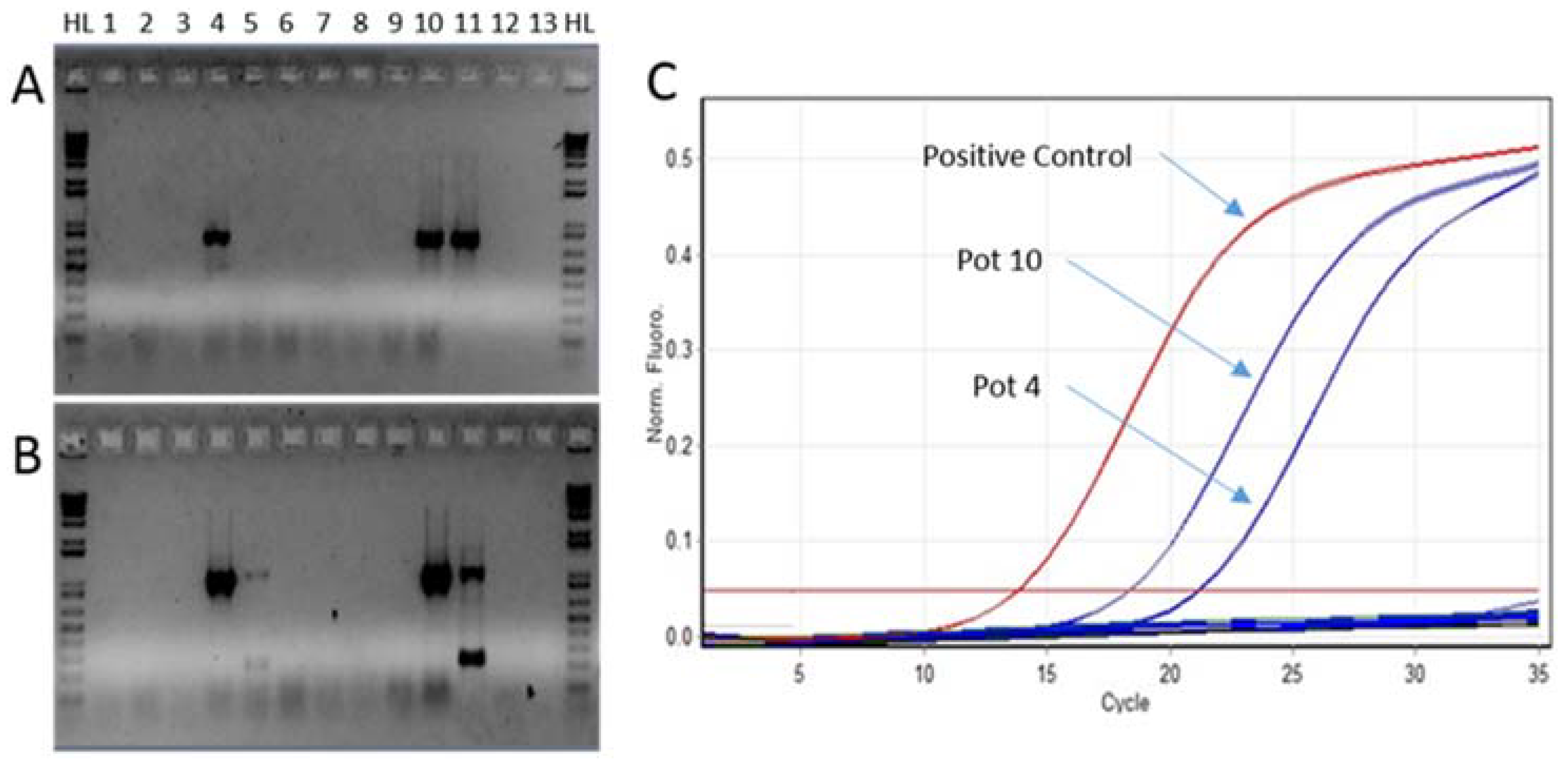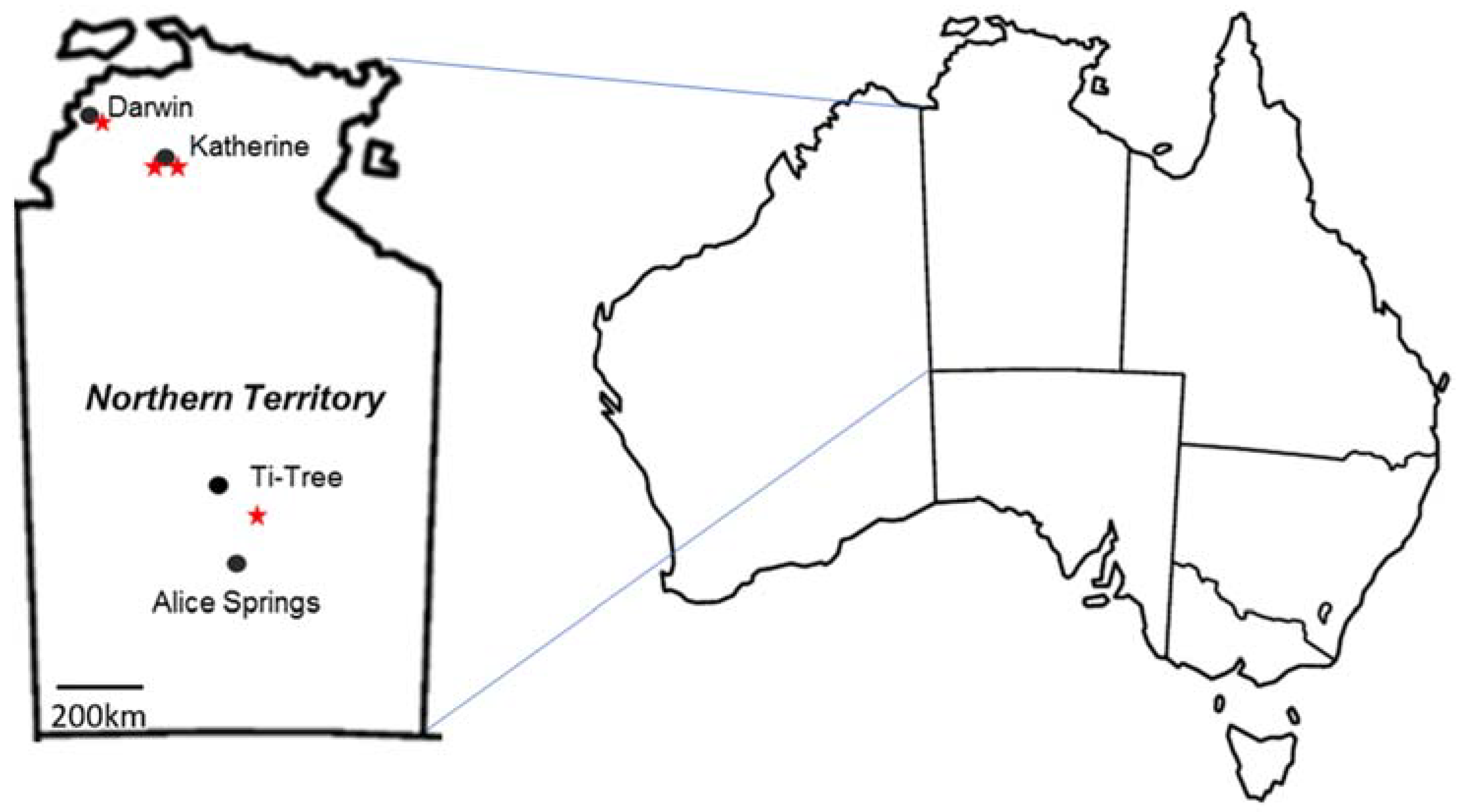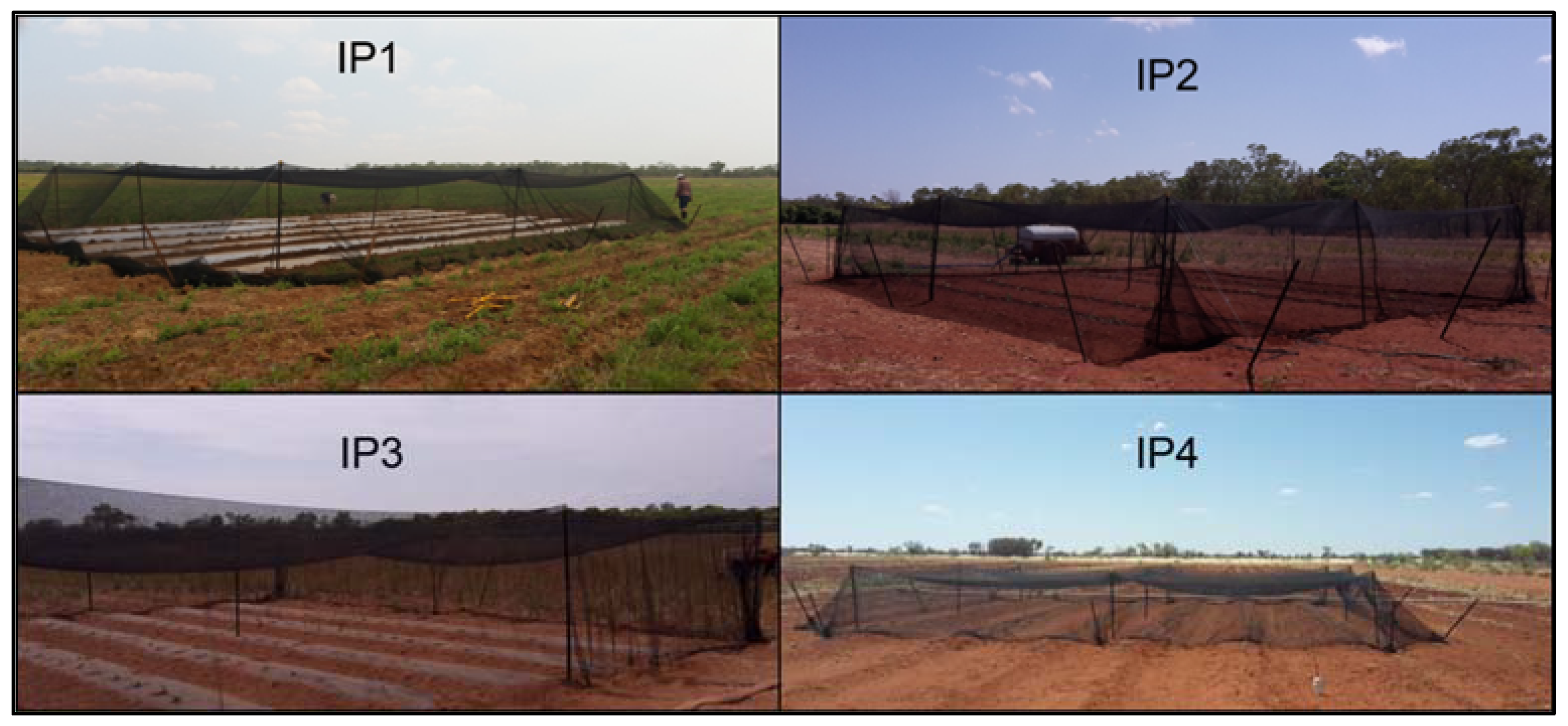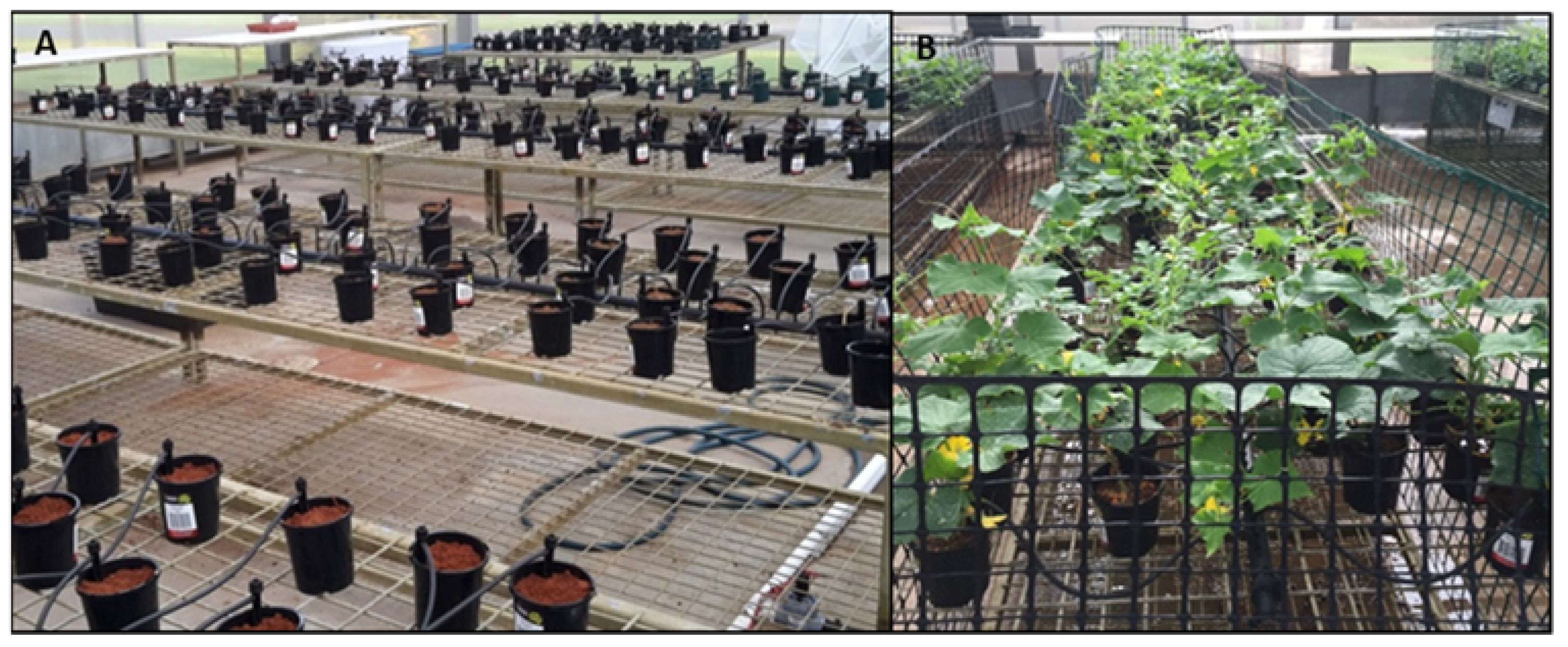Investigating the Longevity and Infectivity of Cucumber green mottle mosaic virus in Soils of the Northern Territory, Australia
Abstract
1. Introduction
2. Results
2.1. Field and Screenhouse Trials
2.1.1. Infectivity of CGMMV in Soil
2.1.2. Virus and Soil Disinfection
3. Discussion
3.1. Survival of CGMMV in Soil
3.2. Infectivity of CGMMV in Soil
3.3. Disinfection of Infested Soil
4. Materials and Methods
4.1. Infested Property Selection and Soil Sampling
4.2. Plant Growth and Field and Screenhouse Trials
4.3. CGMMV Inoculum Preparation and Disinfection of CGMMV
4.4. Soil Infectivity and Disinfection
4.5. Isolation of Viral RNA, PCR Primers and Conditions
Author Contributions
Funding
Institutional Review Board Statement
Informed Consent Statement
Data Availability Statement
Acknowledgments
Conflicts of Interest
References
- Ainsworth, G.C. Mosaic diseases of the cucumber. Ann. Appl. Biol. 1935, 22, 55–67. [Google Scholar] [CrossRef]
- Dombrovsky, A.; Tran-Nguyen, L.T.; Jones, R.A. Cucumber green mottle mosaic virus: Rapidly Increasing Global Distribution, Etiology, Epidemiology, and Management. Annu. Rev. Phytopathol. 2017, 55, 231–256. [Google Scholar] [CrossRef] [PubMed]
- Tesoriero, L.A.; Chambers, G.; Srivastava, M.; Smith, S.; Conde, B.; Tran-Nguyen, L.T.T. First report of cucumber green mottle mosaic virus in Australia. Australas. Plant Dis. Notes 2015, 11, 1. [Google Scholar] [CrossRef]
- Taylor, R.H.; Grogan, R.G.; Kimble, K.A. Transmission of Tobacco mosaic virus in tomato seeds. Phytopathology 1961, 51, 837–842. [Google Scholar]
- Ko, S.-J.; Lee, Y.-H.; Cha, K.-H.; Lee, T.-S.; Park, I.-J. Sap Transmission Pattern of CGMMV and Effect of Disinfectant on Watermelon. Res. Plant Dis. 2004, 10, 150–153. [Google Scholar] [CrossRef][Green Version]
- Kim, S.-M.; Nam, S.-H.; Lee, J.-M.; Yim, K.-O.; Kim, K.-H. Destruction of Cucumber green mottle mosaic virus by heat treatment and rapid detection of virus inactivation by RT-PCR. Mol. Cells 2003, 16, 338–342. [Google Scholar]
- Liu, H.W.; Luo, L.X.; Li, J.Q.; Liu, P.F.; Chen, X.Y.; Hao, J.J. Pollen and seed transmission of Cucumber green mottle mosaic virus in cucumber. Plant Pathol. 2014, 63, 72–77. [Google Scholar] [CrossRef]
- Li, J.-X.; Liu, S.-S.; Gu, Q.-S. Transmission Efficiency of Cucumber green mottle mosaic virus via Seeds, Soil, Pruning and Irrigation Water. J. Phytopathol. 2016, 5, 300–309. [Google Scholar] [CrossRef]
- Smith, E.; Dombrovsky, A. Aspects in Tobamovirus Management in Intensive Agriculture. In Plant Diseases—Current Threats and Management Trends; IntechOpen: London, UK, 2019. [Google Scholar]
- Northern Territory, Department of Primary Industries & Resources. Annual Report 2017/2018; Northern Territory Government: Darwin, Australia, 2018.
- Kehoe, M.A.; Jones, R.A.C.; Coutts, B.A. First Complete Genome Sequence of Cucumber green mottle mosaic virus Isolated from Australia. Genome Announc. 2017, 5, e00036-17. [Google Scholar] [CrossRef]
- Fillhart, R.C.; Bachand, G.; Castello, J.D. Detection of Infectious Tobamoviruses in Forest Soils. Appl. Environ. Microbiol. 1998, 64, 1430–1435. [Google Scholar] [CrossRef]
- Pleše, N.; Juretić, N.; Mamula, D.; Polák, Z.; Krajačić, M. Plant Virus in Soil and Water of Rorest Ecosystems in Croatia. Phyton 1996, 36, 135–143. [Google Scholar]
- Castello, J.D.; Rogers, S.O.; Starmer, W.T.; Catranis, C.M.; Ma, L.; Bachand, G.D.; Zhao, Y.; Smith, J.E. Detection of tomato mosaic tobamovirus RNA in ancient glacial ice. Polar Biol. 1999, 22, 207–212. [Google Scholar] [CrossRef]
- Gülser, C.; Yılmaz, N.K.; Candemir, F. Accumulation of Tobacco mosaic virus (TMV) at different depths clay and loamy sand textural soils due to tobacco waste application. Environ. Monit. Assess. 2008, 146, 235–242. [Google Scholar] [CrossRef] [PubMed]
- Candemir, F.; Kutluk-Yilmaz, N.D.; Gϋlser, C. The effect of N. benthamiana waste application on Tobacco mosaic virus (TMV) concentration in the soil. Agriculture 2012, 99, 99–103. [Google Scholar]
- Varveri, C.; Vassilakos, N.; Bem, F. Characterization and detection of Cucumber green mottle mosaic virus in Greece. Phytoparasitica 2002, 30, 493–501. [Google Scholar] [CrossRef]
- Lewandowski, D.J.; Hayes, A.J.; Adkins, S. Surprising Results from a Search for Effective Disinfectants for Tobacco mosaic virus - Contaminated Tools. Plant Dis. 2010, 94, 542–550. [Google Scholar] [CrossRef]
- Coutts, B.A.; Kehoe, M.A.; Jones, R.A.C. Zucchini yellow mosaic virus: Contact Transmission, Stability on Surfaces, and Inactivation with Disinfectants. Plant Dis. 2013, 97, 765–771. [Google Scholar] [CrossRef]
- Reingold, V.; Lachman, O.; Belausov, E.; Koren, A.; Mor, N.; Dombrovsky, A. Epidemiological study of Cucumber green mottle mosaic virusin greenhouses enables reduction of disease damage in cucurbit production. Ann. Appl. Biol. 2016, 168, 29–40. [Google Scholar] [CrossRef]
- Choi, G.-S.; Kim, J.-H.; Kim, J.-S. Soil Transmission of Cucumber green mottle mosaic virus and its control measures in watermelon. Res. Plant Dis. 2004, 10, 44–47. [Google Scholar] [CrossRef]
- Adkins, S.; Rosskopf, E.N. Key West Nightshade, a New Experimental Host for Plant Viruses. Plant Dis. 2002, 86, 1310–1314. [Google Scholar] [CrossRef]
- Darzi, E.; Smith, E.; Shargil, D.; Lachman, O.; Ganot, L.; Dombrovsky, A. The honeybee Apis mellifera contributes to Cucumber green mottle mosaic virus spread via pollination. Plant Pathol. 2018, 67, 244–251. [Google Scholar] [CrossRef]
- Choi, G.-S. Occurrence of two tobamovirus diseases in cucurbits and control measures in Korea. J. Plant Pathol. 2001, 17, 243–248. [Google Scholar]
- Park, J.-W.; Jang, T.-H.; Song, S.-H.; Choi, H.-S.; Ko, S.-J. Studies on the Soil Transmission of CGMMV and Its Control with Crop Rotation. Korean J. Pestic. Sci. 2010, 14, 473–477. [Google Scholar]
- Nakamura, H. Effects of Dry Heat Treatment for Seed Disinfection on Germination in Vegetables. J. Agric. Res. 1982, 15, 243–247. [Google Scholar]
- Herrera-Vásquez, J.A.; Sellés, M.D.C.C.; Cebrián, M.C.; Alfaro-Fernández, A.; Jordá, C. Seed transmission of Melon necrotic spot virus and efficacy of seed-disinfection treatments. Plant Pathol. 2009, 58, 436–442. [Google Scholar] [CrossRef]
- Kubota, M.; Hagiwara, N.; Shirakawa, T. Disinfection of Seeds of Cucurbit Crops Infested with Acidovorax citrulli with Dry Heat Treatment. J. Phytopathol. 2012, 160, 364–368. [Google Scholar] [CrossRef]
- Reingold, V.; Lachman, O.; Blaosov, E.; Dombrovsky, A. Seed disinfection treatments do not sufficiently eliminate the infectivity of Cucumber green mottle mosaic virus (CGMMV) on cucurbit seeds. Plant Pathol. 2015, 64, 245–255. [Google Scholar] [CrossRef]
- Shargil, D.; Smith, E.; Lachman, O.; Reingold, V.; Darzi, E.; Tam, Y.; Dombrovsky, A. New weed hosts for Cucumber green mottle mosaic virus in wild Mediterranean vegetation. Eur. J. Plant Pathol. 2017, 148, 473–480. [Google Scholar] [CrossRef]
- Ling, K.-S.; Li, R.; Zhang, W. First Report of Cucumber green mottle mosaic virus Infecting Greenhouse Cucumber in Canada. Plant Dis. 2014, 98, 701. [Google Scholar] [CrossRef]
- Shargil, D.; Zemach, H.; Belausov, E.; Lachman, O.; Luria, N.; Molad, O.; Smith, E.; Kamenetsky, R.; Dombrovsky, A. Insights into the maternal pathway for Cucumber green mottle mosaic virus infection of cucurbit seeds. Protoplasma 2019, 256, 1109–1118. [Google Scholar] [CrossRef]
- Berendsen, S.; Oosterhof, J. TaqMan Assays Designed on the Coding Sequence of the Movement Protein of Cucumber green mottle mosaic virus for its Detection in Cucurbit Seeds. In Proceedings of the 2015 APS Annual Meeting, New York, NY, USA, 21–24 May 2015. [Google Scholar] [CrossRef]
- Thompson, J.; Wetzel, S.; Klerks, M.; Vašková, D.; Schoen, C.; Špak, J.; Jelkmann, W. Multiplex RT-PCR detection of four aphid-borne strawberry viruses in Fragaria spp. in combination with a plant mRNA specific internal control. J. Virol. Methods 2003, 111, 85–93. [Google Scholar] [CrossRef]





| Location | 12 Month Field Trial | 12 Month Bioassay | 15 Month Bioassay | 18 Month Bioassay |
|---|---|---|---|---|
| IP1 | 0/8 1 | 1/8 | 4/8 | NA 2 |
| IP2 | 1/8 | 0/8 | 5/8 | NA |
| IP3 | 0/8 | 2/8 | 5/8 | 0/8 |
| IP4 | 0/8 | 0/8 | 3/8 | 1/8 |
| Sample | Positive/Total Pots | % Infected |
|---|---|---|
| 1 | 0/5 1 | 0 2 |
| 2 | 0/5 | 0 |
| 3 | 0/5 | 0 |
| 5 | 1/5 | 20 |
| 6 | 0/5 | 0 |
| 7 | 0/5 | 0 |
| 8 | 0/5 | 0 |
| 9 | 0/5 | 0 |
| 10 | 0/5 | 0 |
| 11 | 0/5 | 0 |
| 12 | 0/5 | 0 |
| 13 | 2/5 | 40 |
| 14 | 0/5 | 0 |
| Total | 3/70 | 4 |
| Sample (Pot #) | Positive/Negative |
|---|---|
| 1 (Pot 11) | − 1 |
| 2 (Pot 12) | + *,2 |
| 3 (Pot 13) | − |
| 4 (Pot 14) | − |
| 5 (Pot 15) | − |
| 6 (Pot 16) | − |
| 7 (Pot 17) | − |
| 8 (Pot 18) | − |
| 9 (Pot 19) | + |
| 10 (Pot 20) | − |
| 11 (Pot 31) | + |
| 12 (Pot 32) | + * |
| 13 (Pot 33) | − |
| 14 (Pot 34) | + * |
| 15 (Pot 35) | + * |
| 16 (Pot 36) | + * |
| 17 (Pot 38) | + * |
| 18 (Pot 39) | − |
| 19 (Pot 40) | + |
| Time Point | 2% VirkonTM | 1% Bleach | Negative | Positive | ||
|---|---|---|---|---|---|---|
| Watermelon | N. benthamiana | Watermelon | N. benthamiana *,2 | Watermelon | Watermelon | |
| 30 s | − 1 | − | − | − | − | + |
| 1 min | − | − | − | − | − | + |
| 5 min | − | − | − | − | − | + |
Publisher’s Note: MDPI stays neutral with regard to jurisdictional claims in published maps and institutional affiliations. |
© 2022 by the authors. Licensee MDPI, Basel, Switzerland. This article is an open access article distributed under the terms and conditions of the Creative Commons Attribution (CC BY) license (https://creativecommons.org/licenses/by/4.0/).
Share and Cite
Lovelock, D.; Mintoff, S.; Kurz, N.; Neilsen, M.; Patel, S.; Constable, F.; Tran-Nguyen, L. Investigating the Longevity and Infectivity of Cucumber green mottle mosaic virus in Soils of the Northern Territory, Australia. Plants 2022, 11, 883. https://doi.org/10.3390/plants11070883
Lovelock D, Mintoff S, Kurz N, Neilsen M, Patel S, Constable F, Tran-Nguyen L. Investigating the Longevity and Infectivity of Cucumber green mottle mosaic virus in Soils of the Northern Territory, Australia. Plants. 2022; 11(7):883. https://doi.org/10.3390/plants11070883
Chicago/Turabian StyleLovelock, David, Sharl Mintoff, Nadine Kurz, Merran Neilsen, Shreya Patel, Fiona Constable, and Lucy Tran-Nguyen. 2022. "Investigating the Longevity and Infectivity of Cucumber green mottle mosaic virus in Soils of the Northern Territory, Australia" Plants 11, no. 7: 883. https://doi.org/10.3390/plants11070883
APA StyleLovelock, D., Mintoff, S., Kurz, N., Neilsen, M., Patel, S., Constable, F., & Tran-Nguyen, L. (2022). Investigating the Longevity and Infectivity of Cucumber green mottle mosaic virus in Soils of the Northern Territory, Australia. Plants, 11(7), 883. https://doi.org/10.3390/plants11070883






